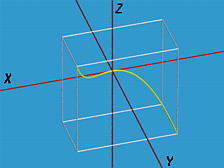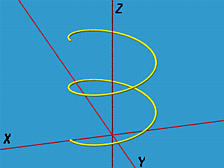

As mentioned in the discussion of boundary representations, each face is surrounded by edges, which could be line segments or curve segments, and the face itself is part of a surface (i.e., a surface patch). In this unit, we shall discuss the general concept of curve segments in parametric form.
A parametric curve in space has the following form:
f: [0,1] -> ( f(u), g(u), h(u) )where f(), g() and h() are three real-valued functions. Thus, f(u) maps a real value u in the closed interval [0,1] to a point in space. The domain of these real functions and vector-valued function f() does not have to be [0,1]. It can be any closed interval; but, for simplicity, we restrict the domain to [0,1]. Thus, for each u in [0,1], there corresponds to a point ( f(u), g(u), h(u) ) in space.
In this course, functions f(), g() and h() are always polynomials.
Note that if function h() is removed from the definition of f(), f() has two coordinate components and becomes a curve in the coordinate plane.

f(u) = b1 + ud1where B = < b1, b2, b3 >, d = < d1, d2, d3 >, and f() is a parametric curve that maps [0,1] to the line segment between B and B+d, inclusive.
g(u) = b2 + ud2
h(u) = b3 + ud3
x(u) = rcos(2*PI*u) + pIt has center (p, q) and radius r. Since the parameter u is in [0,1], the value of 2*PI*u is in [0,2*PI] (i.e., from 0 degree to 360 degree).
y(u) = rsin(2*PI*u) + q
Let us eliminate u. First, change the above equations to the following. For convenience, we drop (u) from x(u) and y(u).
x - p = rcos(2*PI*u)Then, squaring both equations and adding them together yields
y - q = rsin(2*PI*u)
(x - p)2 + (y - q)2 = r2Thus, it shows that the given parametric curve is indeed a circle with center at (p, q) and radius r.
f(u) = uThe following figure shows this curve in the range of [-1,1]. It is contained in the box (in white) defined by ( -1, 0, -1 ) and (1, 1, 1)
g(u) = u2
h(u) = u3

f(u) = ( acos(u), asin(u), bu )The following figure shows the curve in [0, 4*PI]. The initial point is (a, 0, 0) and the endpoint is (a, 0, b*4*PI). Note that this curve lies on the cylinder of radius a and axis the z-axis.
